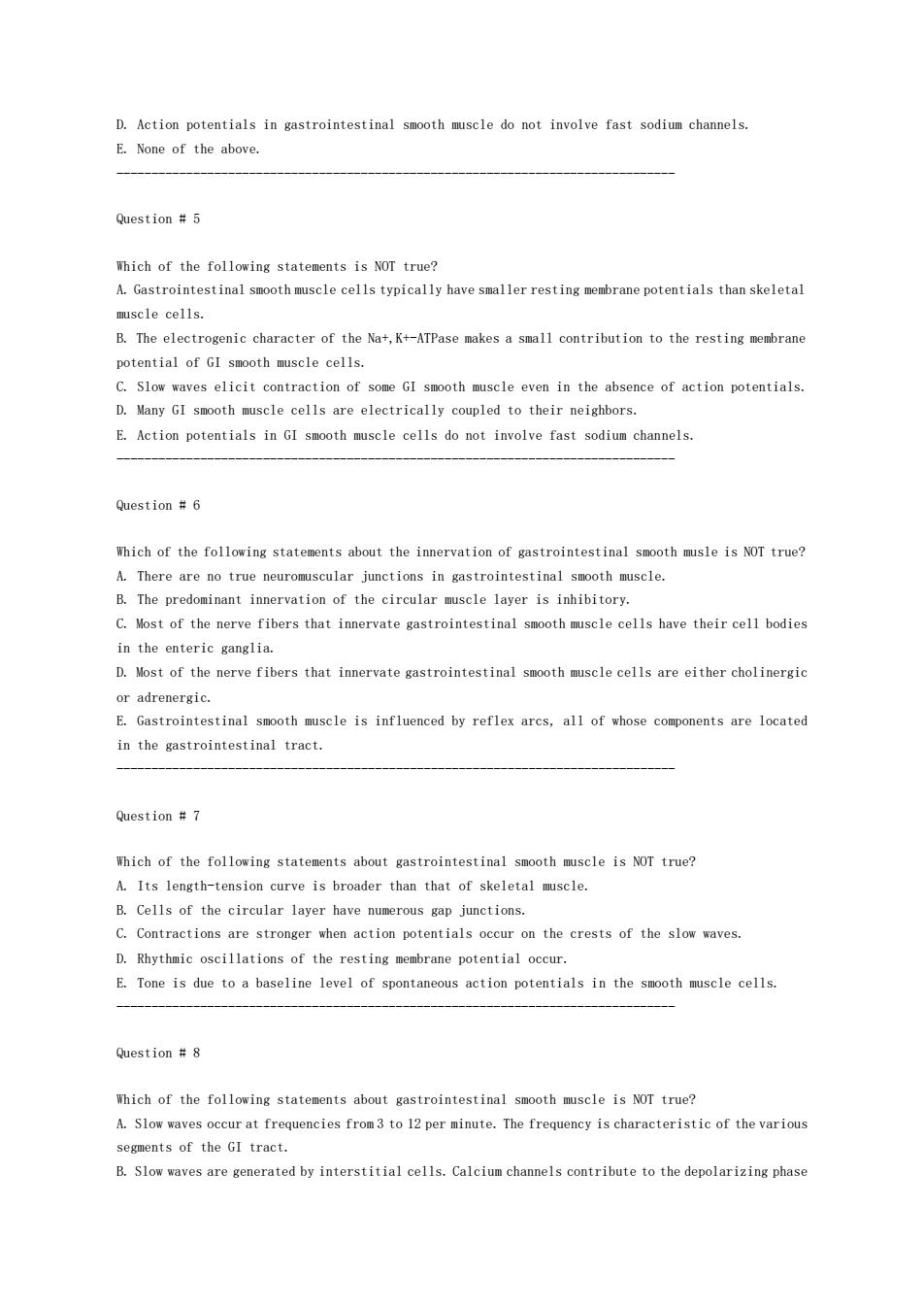正在加载图片...

D.Action potentials in gastrointestinal smooth muscle do not involve fast sodium channels. E.None of the above Question#5 Which of the following statements is NOT true? A.Gastrointestinal smooth muscle cells typically have smaller resting membrane potentials than skeletal muscle cells. B.The electrogenic character of the Na,K+-ATPase makes a small contribution to the resting brane ntial of GI oth auscle cells C.Slow waves elicit contraction of some GI smooth muscle even in the absence of action potentials. D.Many GI saooth muscle cells are electrically coupled to their neighbors. E.Action potentials in GI smooth muscle cells do not involve fast sodium channels Question#6 Which of the following statements about the innervation of gastrointestinal sooth musle is NOT true? A.There are no true neuromuscular junctions in gastrointestinal smooth muscle. B.The predominant innervation of the circular muscle layer is inhibitory. C.Most of the nerve fibers that innervate gastrointestinal snooth muscle cells have their cell bodies in the enteric ganglia. D.Most of the nerve fibers that innervate gastrointestinal smooth muscle cells are either cholinergic or adrenergic E.Gastrointestinal smooth muscle is influenced by reflex arcs,all of whose components are located in the gastrointestinal tract. Question#7 Which of the following statements about gastrointestinal smooth mscle is NOT true? A.Its length-tension curve is broader than that of skeletal muscle. B.Cells of the circular layer have numerous gap junctions. C.Contractions are stronger when action potentials occur on the crests of the slow waves. D.Rhythmic oscillations of the resting merbrane potential occur E Tone is due to a baseline level of spontaneous action potentials in the smooth muscle cells. Question#8 Which of the following statements about gastrointestinal smooth muscle is NOT true? A.Slow waves occur at frequencies from3 to 12 per minute.The frequency is characteristic of the various segments of the GI tract. B.Slow waves are generated by interstitial cells.Calcium channels contribute to the depolarizing phas D. Action potentials in gastrointestinal smooth muscle do not involve fast sodium channels. E. None of the above. -------------------------------------------------------------------------------- Question # 5 Which of the following statements is NOT true? A. Gastrointestinal smooth muscle cells typically have smaller resting membrane potentials than skeletal muscle cells. B. The electrogenic character of the Na+,K+-ATPase makes a small contribution to the resting membrane potential of GI smooth muscle cells. C. Slow waves elicit contraction of some GI smooth muscle even in the absence of action potentials. D. Many GI smooth muscle cells are electrically coupled to their neighbors. E. Action potentials in GI smooth muscle cells do not involve fast sodium channels. -------------------------------------------------------------------------------- Question # 6 Which of the following statements about the innervation of gastrointestinal smooth musle is NOT true? A. There are no true neuromuscular junctions in gastrointestinal smooth muscle. B. The predominant innervation of the circular muscle layer is inhibitory. C. Most of the nerve fibers that innervate gastrointestinal smooth muscle cells have their cell bodies in the enteric ganglia. D. Most of the nerve fibers that innervate gastrointestinal smooth muscle cells are either cholinergic or adrenergic. E. Gastrointestinal smooth muscle is influenced by reflex arcs, all of whose components are located in the gastrointestinal tract. -------------------------------------------------------------------------------- Question # 7 Which of the following statements about gastrointestinal smooth muscle is NOT true? A. Its length-tension curve is broader than that of skeletal muscle. B. Cells of the circular layer have numerous gap junctions. C. Contractions are stronger when action potentials occur on the crests of the slow waves. D. Rhythmic oscillations of the resting membrane potential occur. E. Tone is due to a baseline level of spontaneous action potentials in the smooth muscle cells. -------------------------------------------------------------------------------- Question # 8 Which of the following statements about gastrointestinal smooth muscle is NOT true? A. Slow waves occur at frequencies from 3 to 12 per minute. The frequency is characteristic of the various segments of the GI tract. B. Slow waves are generated by interstitial cells. Calcium channels contribute to the depolarizing phase